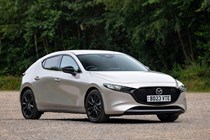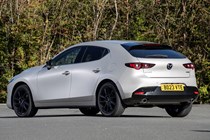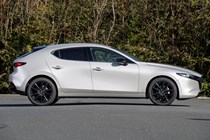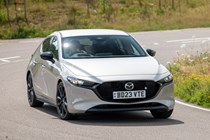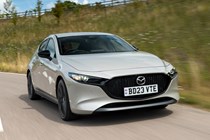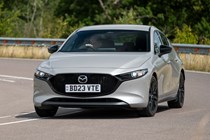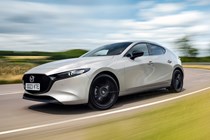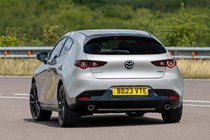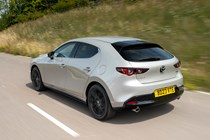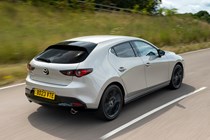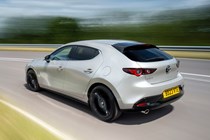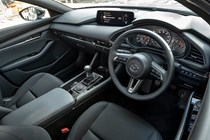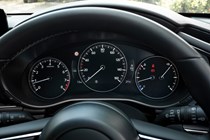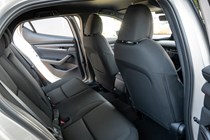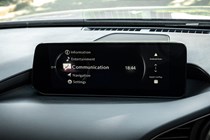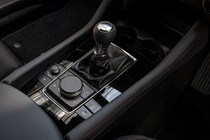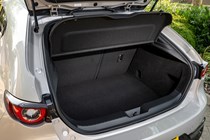
Mazda 3 long-term test
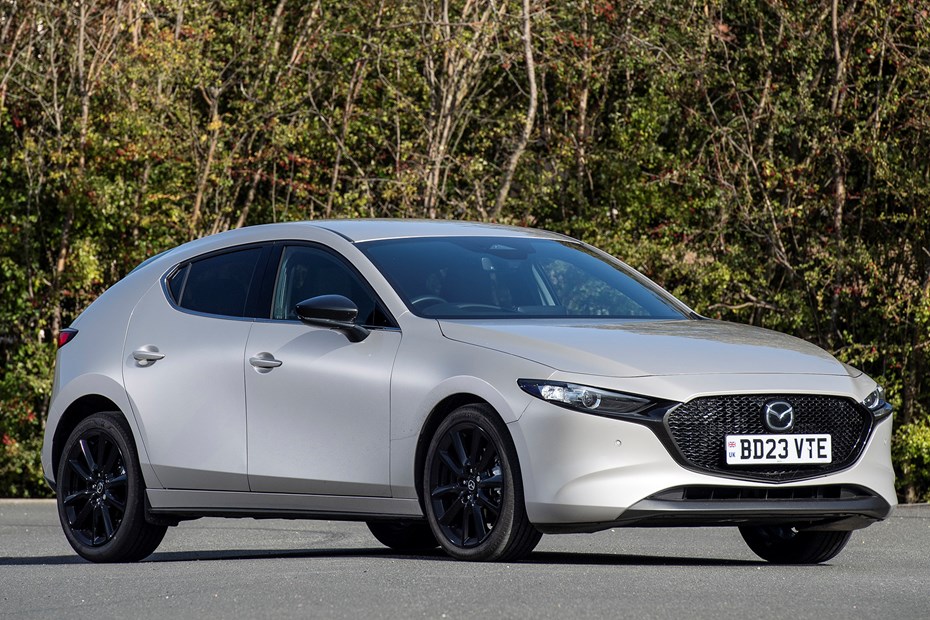
Living with a Mazda 3: the revisit
Update 1: Welcome
Introducing the Mazda 3 e-skyactiv G 140hp
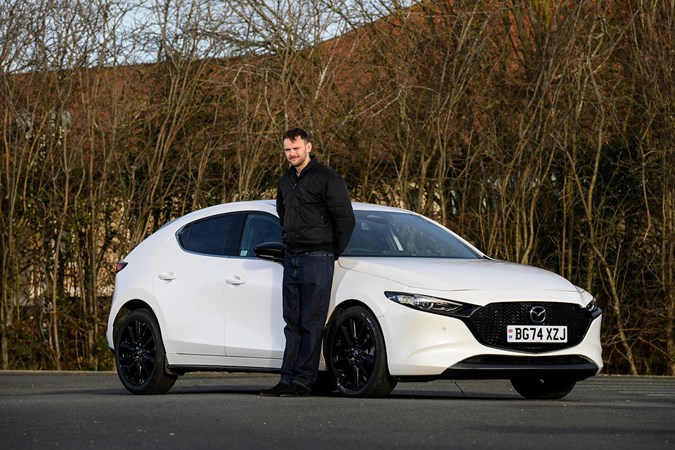
It’s been five years since we last had a Mazda 3 long term test car at Parkers, and now we’ve got a new one.
I’ve been chosen to run it for the next six months, and for me personally, it’s a bit of a manufacturer-specific upgrade. Prior to this Mazda3, I was temporary custodian of a Mazda 2 Hybrid – essentially a rebadged Toyota Yaris. I thought the Yari..er… Mazda 2 Hybrid was okay, but collection day of this bigger brother had me excited. More interior room, a pokier engine, plusher seats and, more importantly, an opportunity to explore what the real Mazda brand is all about. Let’s get into it.
The Mazda 3 I’m running is a Homura trim car – the halfway point in the trim range – powered by the weaker of the two engines on offer. Mazda will let you spec your 3 with either a 140hp or 186hp engine, manual or automatic. Mine is a 140hp manual, which makes it the bottom-spec engine choice in the range, though still with a lot to give.
The 2.5-litre four-cylinder engine in my car is noteworthy because it’s new for 2025. Known as the e-Skyactiv G, my 2.5-litre unit replaces the old 2.0-litre engine that was once offered, delivering 18 more horsepower to the engine entry-point of the Mazda 3 range, along with more torque lower down in the rev range. In the real world, that translates to a faster 0-62mph time, Mazda says. A drag race against the old engine, perhaps. For serious consumer journalism purposes.
What you get with a Homura Mazda 3
Homura spec cars start from £26,060, but as tested my car is £26,210 with the Snowflake White paint job. Here are the top five features that come equipped on Homura-spec 3s:
- Amazon Alexa In-Car Voice Assistant
- 10.25” Colour entertainment display with Mazda Connect infotainment
- Heated front seats
- Qi wireless charging
- Smart keyless entry
It feels appropriately appointed, while the cabin itself, though a little bland, is at least well assembled. It’s a curious interior that in ways feels both modern and infuriatingly dated in some regards, but more on that later. I intend to really put the Mazda 3 through its paces over the coming months, covering thousands of miles in varying conditions to get to the bottom whether it’s still a discerning choice after all these years. On paper it’s a smart affordable option that promises both frugality, comfort and practicality in one package. Does it stack up? Stay tuned to find out.
Update 2: Cabin, equipment and options
The Mazda 3’s cabin is tastefully appointed, well-built and generally pleasant to spend long periods in. That said, it’s rather dull, and the infotainment is a bother.
Generally speaking, I like the Mazda 3’s interior. It feels very well built and it’s stood up to the wear and tear of my last two months in it well. Though the seats could be a little more comfortable, I haven’t found myself especially fatigued after some long periods at the wheel.
My Homura trim car is finished in the black cloth, which is reasonably pleasant to spend time in, though black leather is also available in Takumi trim for three-and-a-half grand more. The cabin is, however, a little too business-like to really stir my soul. Paired with my car’s white paint and it’s just a rather bland configuration. Neat, tidy and high quality, but uninspiring, and not one I particularly look forward to getting back into. To make matters worse, black is the only interior trim colour available, either in cloth with black or red stitching, or leather.
Though the interior options list is quite long, my car’s only additional feature is the £600 snowflake white paint job. Is it worth the money? Absolutely not. White does not suit this car at all, to my eyes. It seems to dirty up quickly, and gives the car a tacky look. If it were my money, I’d be more interested in the Deep Crystal Blue or the Polymetal Grey for the same price.
The cabin is also starting to look rather dated. In some ways I’ve enjoyed it, watching the revs rise on an analogue dial has been refreshing, and the physical buttons have been a huge boon to convenience on the road, but in other departments it’s driven me mad. Read more below…
Infotainment
The infotainment screen is crisp with sharp graphics. That’s all well. The digital menus are easy to navigate through and clearly labelled, but the rotator wheel is a complete and utter nuisance. While on the go, the touch-control ability of the screen ceases to work. Admittedly the screen is quite far away from you in the driver’s seat, and reaching over might be a little distracting at speed, but not nearly as distracting as endlessly taking your eyes off the road to locate where your selector is on the display.
With Apple CarPlay engaged, I’ve had to constantly rotate forward and backwards to arrive at the desired button or widget. Taking my eyes off the road just to figure out where I am in the menu set up before rotating accordingly again/
In time sensitive situations, say reacting to a navigation pop up, it’s lead me to miss turn offs, or choose incorrect routes. Such a design feels outdated, unnecessary, and dangerous. The wheel could be the infotainment’s primary navigation tool, but why bother disengaging the touch control? I’d far rather lean forward to touch a button than spend the next 5 minutes just trying to find it.
In all honesty it’s put me off the Mazda 3 altogether. I’d sooner opt for one of its rivals just to avoid using such an outdated and infuriating system. The rest of the car world offers touch-screens that work on the move, so why not Mazda? Hopefully the 3 will be able to redeem itself in the coming months.
| Current mileage | 4165 |
| Real-world average fuel economy | 40.6 mpg |
| Official fuel economy | 47.1 – 47.9 mpg (combined) |
| Parkers MPP (Miles Per Pound) calculation | 6.0 – 8.1 |
| Joined Parkers fleet | December 2024 |
Living with a Mazda 3:
Update 1: Welcome
Well, the Audi Q3 has gone and been replaced by something that’s also badged with the same number. Evidently, as you can see in these pictures, my previous SUV has made way for a conventional family hatchback in the form of a Mazda 3.
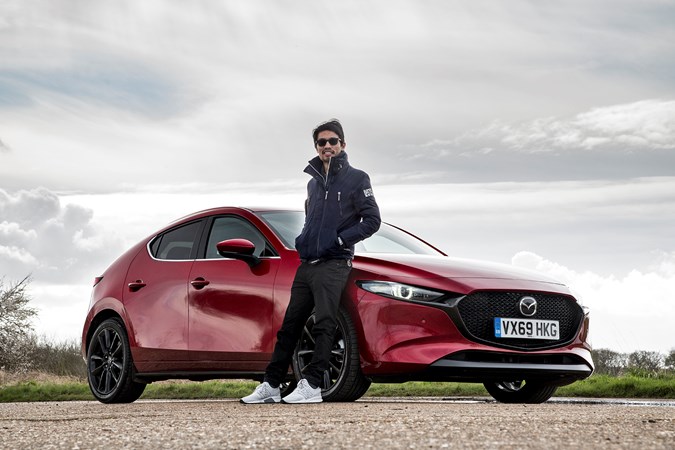
Now in its fourth generation, I reckon it’s the smartest-looking version yet. The shape of the rear isn’t quite as nicely rounded as the last version, but the rest of it looks thoroughly modern, with the front looking refreshingly clean and free of foglights and numerous fake vents.
That said, there is a lot of bodywork on show when viewed from some angles. Not only does it mask the size of our 18-inch wheels, but if you look at our Mazda’s front three-quarters, the combination of that rear windscreen angle and thick rear pillar can sometimes make the 3 look like a hunchback.
Which Mazda 3 do we have?
We’ve got ourselves the mid-range Sport Lux model – which is expected to be the biggest seller – with the most powerful Skyactiv-X engine and a six-speed manual gearbox, although an automatic is available.

This means we have the 180hp 2.0-litre petrol engine with its fuel efficiency-boosting tech, named SPCCI. In short, this is meant to deliver a broad, muscular level of performance in similar character with a diesel engine, as well as improved fuel economy figures.
We’ll find out over the next six months whether we can have the best of both worlds in terms of performance and low running costs.
First impressions
Against its rivals, the Mazda 3 has always been viewed as a hatchback that drove well and provided better value-for-money than a Ford Focus.
Historically though, when it comes to this size of hatchback, I’ve always gone for the latter with the blue oval badge for sheer driving fun. My first car was a 2008 Mk2 facelift, and after switching to a Fiesta afterwards, I went back up in size into a third generation Focus in 2012, followed by the facelifted ST in 2015.
Since joining Parkers, I’ve managed to live with the Ford’s biggest contenders, in the form of a 2015 Volkswagen Golf GT and 2017 Peugeot 308 GTi.
We’ve also run the current Honda Civic on the Parkers long-term fleet and the previous generation Mazda 3 – which was certainly handsome and handled well, but it was lacking spark. Out of all of these, the Honda is probably the closest one I’d have if I had to choose away from the Ford brand.
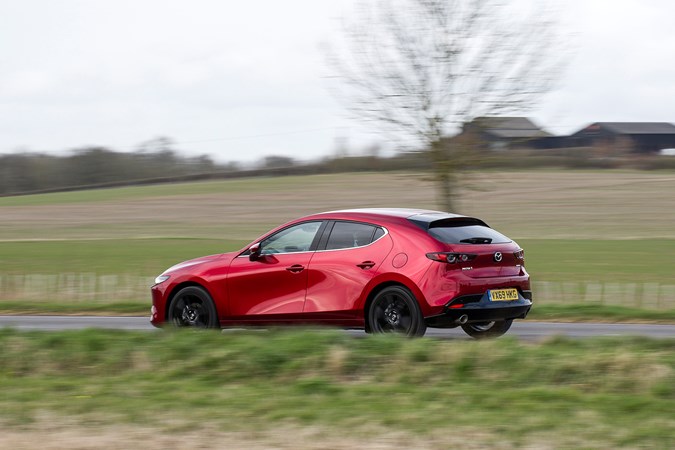
Finished in Soul Red paint and contrasting with the black wheels, front grille and privacy glass, my long-termer certainly appears higher spec than it actually is. It’s definitely an improvement in the looks department for my eyes anyway, but hopefully, the paint isn’t as easily prone to stone chips as it was with our previous Mazda long-termer, the 6 estate.
The interior is dark, but looks very simple to use and I love how the vents on either side of the steering wheel remind me of the Honda S2000. The steering wheel itself is huge, though, and I feel like I’m steering a lorry.
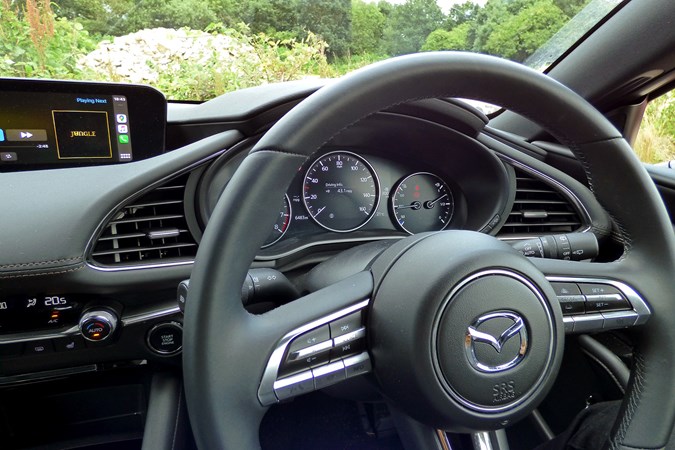
On first impressions, the engine feels a little rough at lower speeds, but the indicated 45.2mpg is pretty impressive for a petrol engine of this size and power. It’s not as fizzy or as eager to rev as the lower-powered version, but we’ll have to see if the added power and fuel economy are worthy trade-offs.
Update 2: What options have we got?
Despite having the mid-spec Sport Lux model, our 3 comes with a generous list of equipment, including: heated front seats, adaptive LED headlights, auto-dimming rear-view mirror, rear LED lights and keyless entry.
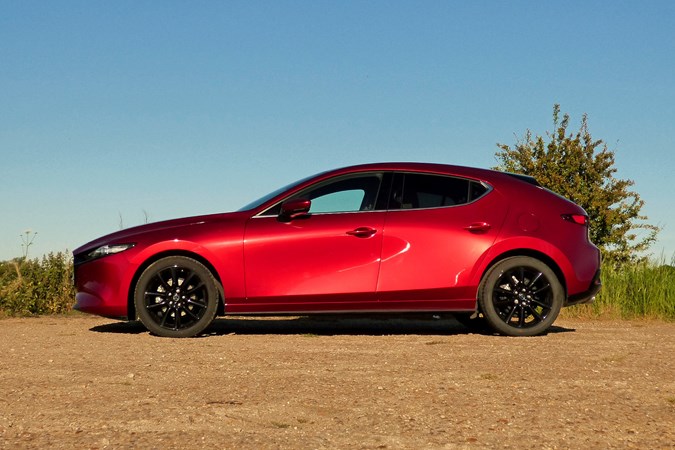
Being the more powerful Skyactiv-X means we have 18-inch black alloy wheels instead of grey ones fitted on the lower-powered engine. I’m personally not a fan of black wheels, but it’s a good way to mark it out from any other models you see on the road.
As a result, the Soul Red metallic paint is the only option we’ve gone for with our 3. I was tempted by the slightly blue Polymetal Grey, but it seemed a little dull for the winter months. Plus, I can’t beat the temptation of this red when I have the chance.
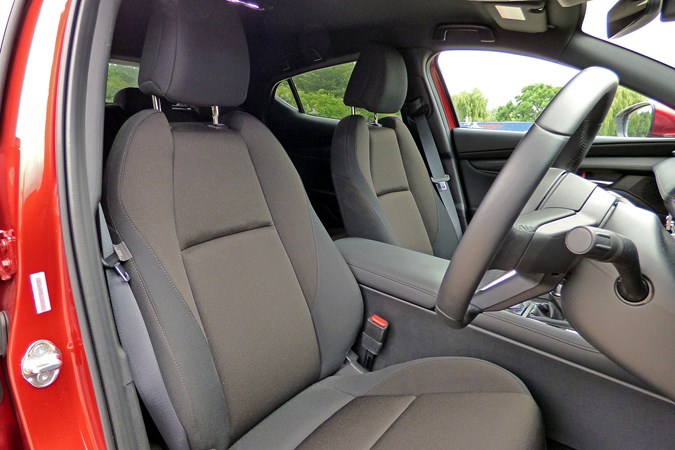
Also, when it comes to the cabin, I generally prefer having cloth seats to leather ones anyway, but I will concede that the burgundy leather interior on higher-spec models is highly tempting if I went for a car in white instead.
Otherwise, the only features I would perhaps wish for would be to have lumbar support for the driver’s seat, a heated steering wheel and the upgraded Bose stereo system, as our standard one is a bit feeble.
Compared to the fantastically-lit cabin of my previous Audi Q3, it’s a shame to find we don’t have any ambient lighting, but it is expected in a car of this class to only find them on top-spec models. That said, you can pay extra for LED footwell lighting at an inconsiderable cost of £20, which would be a box that definitely gets ticked.
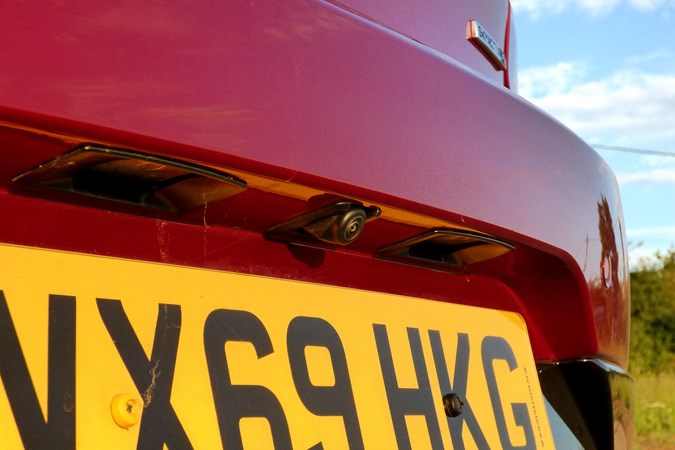
Everything seems to be working well so far. The only gripes relate to the exposed placement of the rear-view camera on the bumper, as it gets covered in dirt in no time, and the adaptive LED headlights – which we’ll delve into how well they work (or don’t), in the next update.
Update 3: What about the bigger CX-30?
I’ll be honest, I was a little sceptical about the CX-30 – not because it does anything particularly wrong, but I couldn’t really see the point of it. In terms of sizing, it’s not much of a leap from our long-termer, looking more like a jacked-up hatchback in a similar ethos to the Lexus UX or Audi Q2.
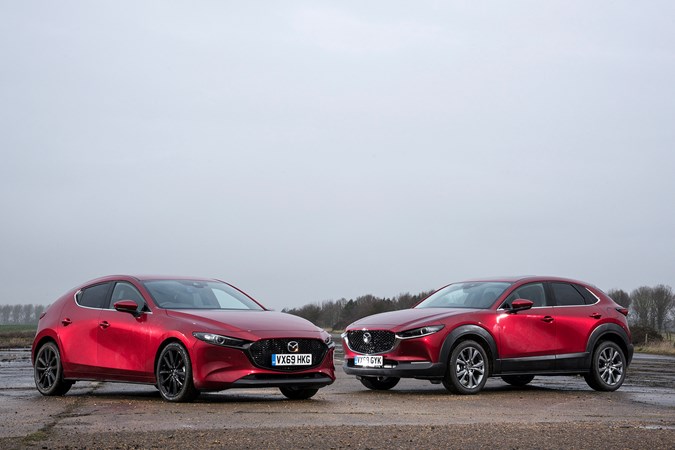
In my mind, you’re just paying extra for some bulky bodywork and a little more inconvenience when it comes to parking in tight spaces – why not go the whole hog and get the more spacious alternatives, such as the Volkswagen Tiguan or, like my previous long-termer, the Audi Q3?
Maybe I was just miserable that day (like I am most days, I guess), but it didn’t take long for the CX-30 to convince.
First of all, it’s far more refined than my 3 hatchback. We both have the same Skyactiv-X engine, but it’s much quieter and sounds less diesel-like in the CX-30.
There are far fewer vibrations being transmitted into the cabin from the driver’s controls, such as the steering wheel and pedals, resulting in a more serene and comfortable experience – don’t get me wrong, our long termer is hardly shaking itself to pieces, but it’s noticeably more relaxing in the SUV.

The hushed levels of road and engine noise still applies in here, while the rides remains on the firmer side, but the extra suspension travel soaks up certain road bumps better.
Yes, the added height means it’s compromised when it comes to handling, but it’s also less cumbersome to thread through twisty roads or narrow towns and villages than a fully-fledged SUV.
There’s not much difference in performance either, as both cars suffer from the same level of lethargy, and fuel economy was indicated at a 10% drop in mpg figures, hovering at 40.5mpg on the trip computer.
Despite the slight increase in body roll, the driving experience wasn’t too different overall – which is great if you’re someone who isn’t looking for a dramatic change, but is it worth the added outlay for buyers wanting to trade up?
Higher spec than our model
Unlike our long-termer, you can’t spec a CX-30 to have a black grille surround up front, which is a bit of a shame, but having a slightly sporting look seems less relevant on the SUV. Since the bigger Mazda is a higher-spec GT-Sport model here, compared to our long-termer’s mid-range Sport Lux, it was a great opportunity to test out any kit we may have missed out on with our hatchback.
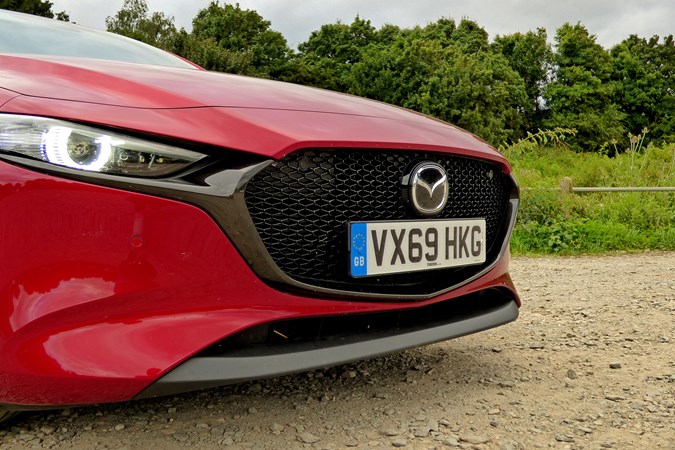
This CX-30’s electrically adjustable leather seats add a touch of luxury, with memory buttons on the lower bank of switches behind the right-hand side of the steering wheel, just below the driver’s air vent. This, I can live without, but the heated steering wheel is definitely a feature I yearn for in the winter months.
Since our standard stereo on the 3 sounds a bit feeble, I was looking forward to the Bose one on the CX-30, but the difference wasn’t as great as I’d hoped – maybe some more time fiddling with the settings and equaliser would have improved matters, but I was hoping it would give me tinnitus.
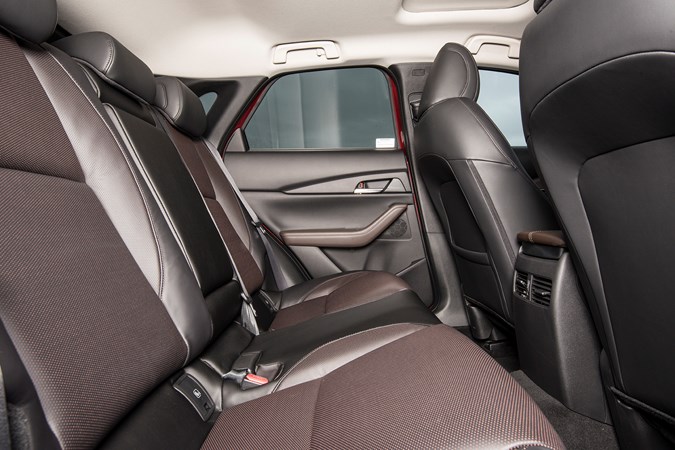
We’ve mentioned about the dark cabin before on our hatch and the sunroof in the CX-30, in conjunction with the lighter roof lining, significantly helps brighten up the interior.
The optional brown interior colour scheme on the SUV may not sound that appealing on paper, but it’s enough to help liven up the cabin a notch in daylight – I like the shade, and it’s far more subtle than the burgundy option you can get on the 3. The only thing missing in the CX-30 is the multiple-tiered look of the dashboard over on the passenger side, which I love on my long-termer as it breaks up the width of the dash.
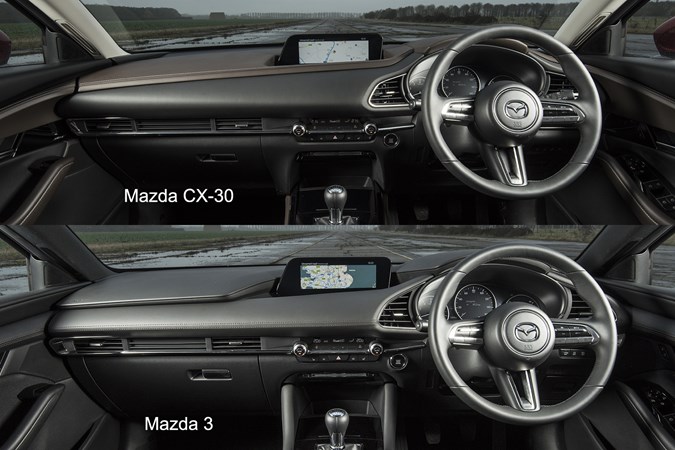
So, would I get a CX-30? I still find these bloated hatchbacks a little niche, but if you treat them as a stepping-stone to a full-size SUV, the CX-30 is a handsome way to go.
If anything, I guess I’d simply view this CX-30 as more of a grown-up hatch: trade in some of the 3’s driving fun for a bigger boot and slightly more interior space and it might be the answer for your growing family.
Update 4: Practicality
As someone who doesn’t have children and only occasionally wants to let people in, the Mazda 3 has all the space I need to live with on a day-to-day basis. It’s been practical enough for one person who usually just takes luggage to the airport, but the few times we have used it with four adults on board, those sat in the rear have wished for a little more kneeroom.
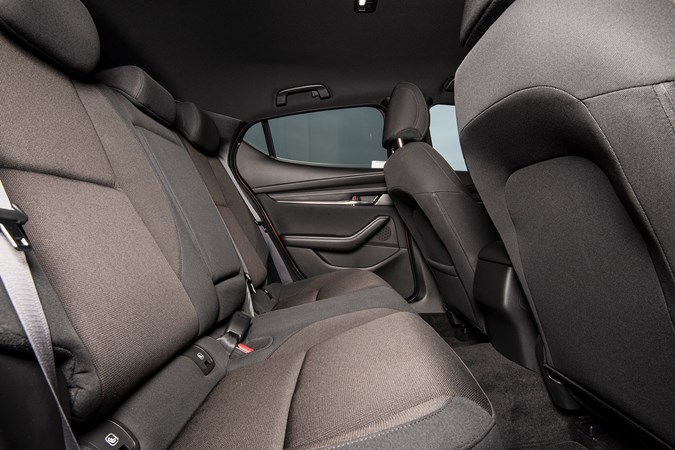
When you have adults sitting up front who are more than 6ft tall and slide their seats back, those in the rear will have their legs bunched up, digging their knees into the front seats. That’s not to say the Mazda’s particularly mean in this department: The Toyota Corolla is even more cramped, as well as having a higher sense of claustrophobia thanks to its small rear windows – and even the larger Volkswagen T-Roc I tested recently felt quite restrictive when it came to legroom – even if the raised seat base itself takes up some of the slack.
The other gripe for me is that access is a little restricted as well – the 3’s doors are mounted quite low on the bodywork, so it’s quite easy to bang your head on the roof when getting in and out. This also limits the view out for taller passengers when sat inside, as the roofline curves down at the sides to your eye level. We find this to be quite common on saloon cars – with the biggest culprit I find being the Jaguar XE – but it’s not so common with hatchbacks. At least that brings the roof-mounted grab handles lower and easier to reach, if you want a silver lining…
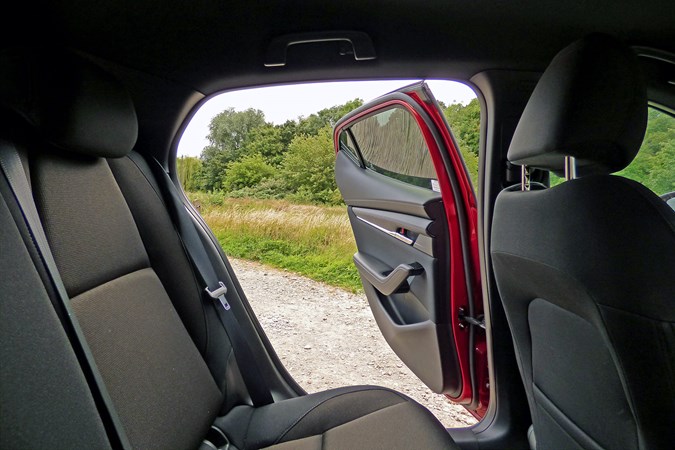
For those with rear passenger space higher on their priority list, a Ford Focus or the latest SEAT Leon is a little more generous, but you could go even further by checking out the Skoda Scala – which almost looks stretched in this company.
When it comes to luggage space, the Mazda 3 has taken everything I could throw at it. Apart from moving computer equipment and two weeks-worth of clothing around to see family at Christmas, the only challenge I had was to fit a gearbox from a VW Golf GTI and the exhaust off my Honda Civic to take to the scrapyard – the latter included both the catalyst and centre section as they’d rusted and fused together.
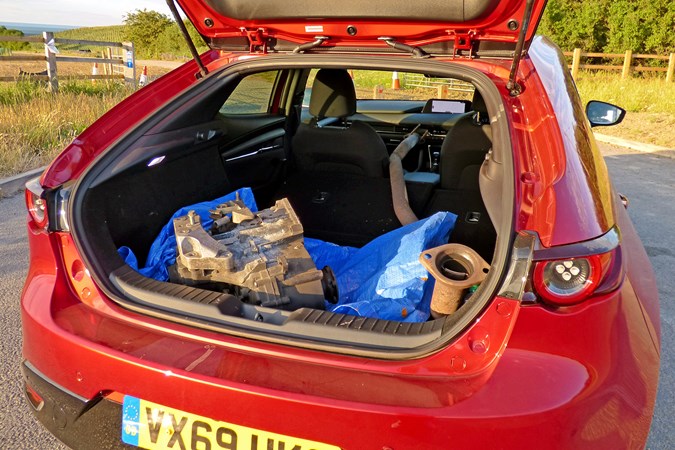
I must admit, as I initially placed the exhaust down on the ground beside the Mazda, I wished I’d chosen a larger car for the task, but our long termer managed with no problems whatsoever – fold the rear seats down, recline the front passenger seat and it rested on the front centre armrest, diagonally through the length of the cabin, sitting an inch shy of the dashboard.
Again, having moved this into the taller Volkswagen T-Roc later that week proved that the slightly bulkier-looking SUV didn’t improve matters by much, as the cabin lengths for both are extremely similar.
There’s also a minor detail that is wonderfully useful – we don’t have a powered tailgate on the boot of our hatch, but the button that would be there is substituted by one that locks the doors. It saves so much time and hassle trying to relocate your keys in whichever pocket you put them in when you’re carrying all your luggage and shopping you’ve just taken out of the boot.
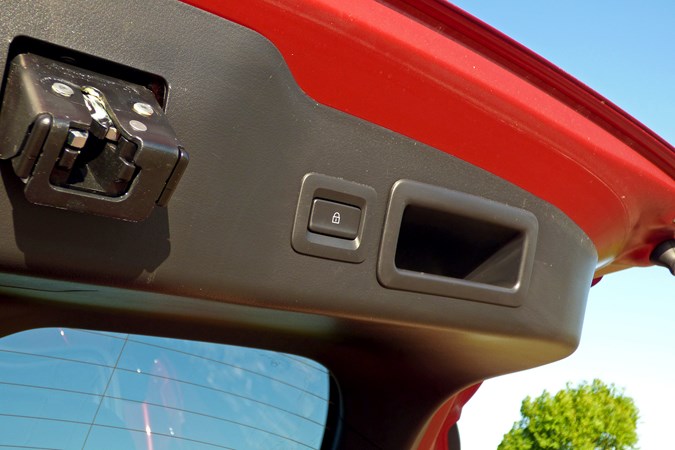
It’s also pretty easy to park thanks to large door mirrors, a rear-view camera and front and rear parking sensors. The front sensors also come on automatically, unlike on some other manufacturers which require pushing a button first, so inching up the driveway is nice and straightforward. As mentioned previously in update two though, the camera does get covered in dirt quite easily.
Update 5: Comfort
My abiding memory of my last long-termer, the Audi Q3, was just how comfortable it was for long-distance journeys. The engine struggled to get up to speed, but once there, the whole car was set up to happily cruise for hours on end with minimal fuss. Thankfully, the Mazda 3 hasn’t been far off from this either.
It’s a refined motorway cruiser. I love how serene it is in here as the cabin does a great job at isolating you from the outside world. Road and wind noise are very well suppressed and betters the Ford Focus, while the engine remains hushed for most of the time.
It’s a shame that it occasionally sounds like a diesel, which isn’t the most pleasing noise to hear, but it’s hardly surprising considering the Skyactiv-X engine adopts a similar method of combusting fuel.
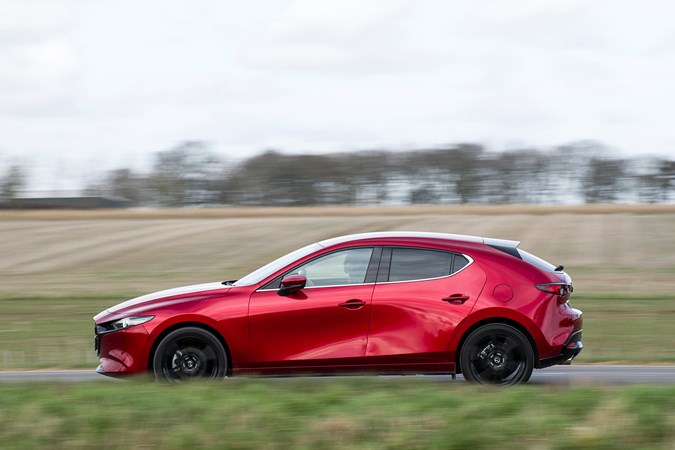
The suspension is set up towards the firmer end of the comfort scale, but it absorbs bumps well enough without kicking up a fuss over rough road surfaces. There’s not much flex from the body either, resulting in a car that simply feels solid and sturdy, while some cars can feel like they’re being battered about.
Our mid-spec model misses out on lumbar support for the driver’s seat, but there’s little to complain about them elsewhere.
Any gripes?
Yes, and they all relate to the tech. The Mazda 3 has a generous kit list with a head-up display, adaptive cruise control and adaptive LED headlights, but the latter two could each do with a patch update for Version 2.0.
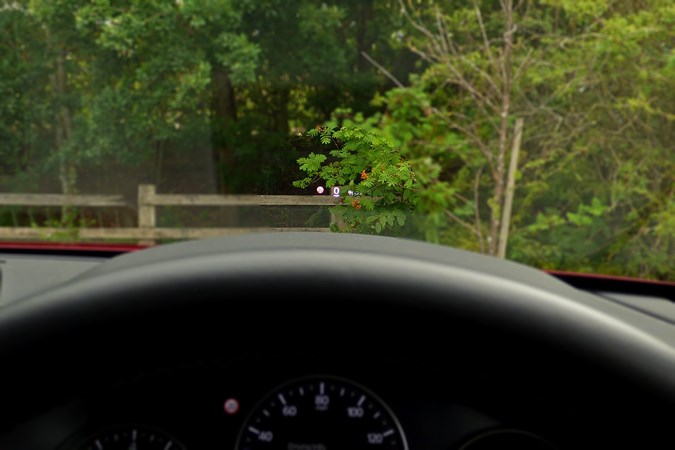
The adaptive cruise control is sensitive enough at detecting cars ahead of you, but the abrupt application of the brakes can be quite unnerving for passengers. Instead of applying the brakes sooner to gently close the gap between you and the vehicle ahead, it simply waits until it reaches the minimum set distance before responding.
Other rivals are much better when it comes to this and so the Mazda 3 doesn’t make for smooth progress when on the motorway – nobody wants to experience like they’re undergoing an emergency stop and lunging forward every time they approach a vehicle – or worse, when a vehicle from another lane moves out in front of them. It’s far from relaxing!
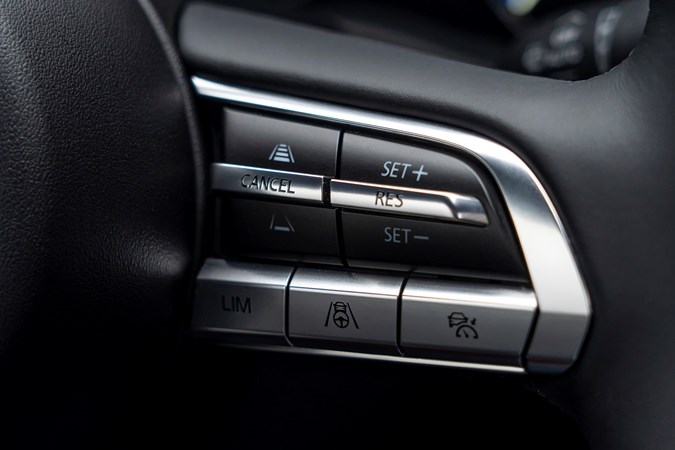
Oddly, it takes forever to regain speed afterwards, so it doesn’t take long for traffic on the outer lanes of the dual carriageway or motorway to catch up with you too – so not only does it disrupt the atmosphere inside the cabin, it disrupts the flow of traffic too.
LED headlights are fine, but adaptive system needs improving
The LED headlights are bright and have a good spread of light. They’re also adaptive, meaning you can still use the brighter high beam setting and it’ll switch off certain sections of the headlight cluster to prevent other vehicles from being blinded.
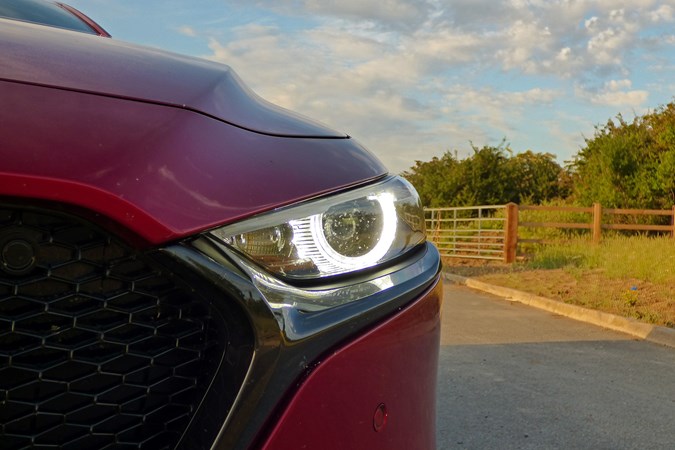
In theory, this is great, but the execution leaves a lot to be desired. It’s better than the DS 3 Crossback’s really basic system, but it’s still not that slick – It didn’t take long to question how effective the system was judging by the glaring reflections I got from the vehicles I would be overtaking.
I also experienced it first-hand when I was being blinded by a vehicle’s headlight reflecting off my door mirror as it overtook me, only to subsequently discover that it was a CX-5 with LED headlights.
To all the other vehicles out there: Sorry, but my retinas also feel your pain.
Update 6: Farewell
So our time with the Mazda 3 SkyActiv-X is up and I’m quite sad to see it go. The smart looks, excellent levels of refinement and long-distance comfort have been its standout points.
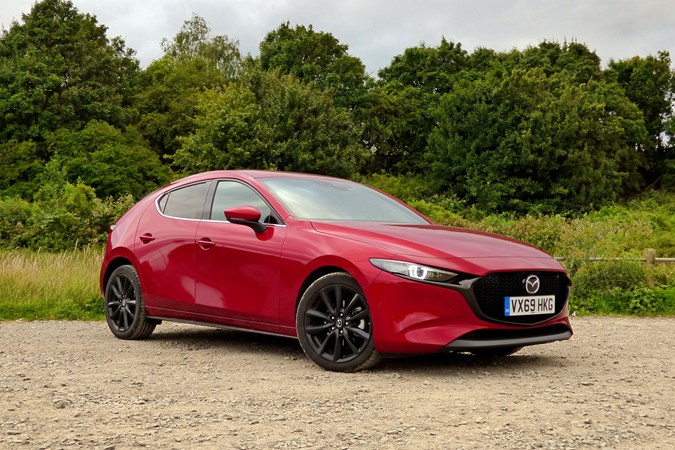
This mid-range Sport Lux is also very close to being the ideal spec, so you don’t necessarily have to fork out for the pricier models to get all the tech you’d need. It also looks like a top-of-the-range model, especially in our fantastic Soul Red paint.
Unfortunately, the paint’s not proven to be any more resilient to stone chips as our previous 6 Estate in the same shade of red – it’s remarkably soft and you can typically find a new hairline scratch or stone chip each time you wash the car.

Otherwise, the 3 is a little sportier to drive than its rivals, thanks to its slightly firm suspension and excellent body control, but the best thing I find about it is how quiet it is. I actually default to driving the 3 in a relaxed manner most of the time, which is just as well, as the sluggish SkyActiv-X engine saps any notion of being fun.
The chassis might make for a fun drive, but the engine doesn’t get you going anywhere quickly, so it can feel like the two are a bit of a mismatch. As a result, if you are looking for a slightly more sporting hatchback, the 3 doesn’t quite work so well overall – admittedly, while Mazda haven’t necessarily described it as one in their literature, it’s what its predecessors have been known for.
Has the latest model started losing its identity, or is it compromising in some areas to be a more rounded car? The brochure certainly describes the Kodo design as being matured, and I suspect the same approach has been applied to the way it drives.
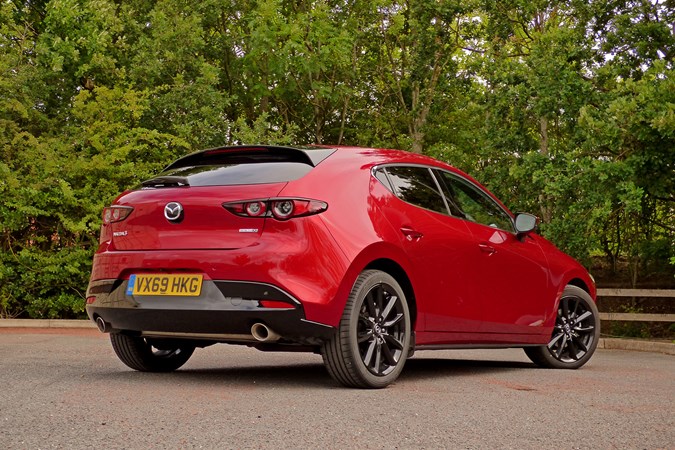
It certainly feels quite grown up, and while it’s not as sharp as the Ford Focus or SEAT Leon, it’s more comfortable than both. The Mazda’s suspension isn’t as firm as the new Leon’s and the cabin is far more hushed than the Ford’s, so it might be a worthy compromise for some. it’s enjoyable enough within its own limits, so stick within the car’s comfort zone and revel in the refinement on offer.
What about this new engine?
The ability to choose a 2.0-litre petrol engine in this size of car has rapidly declined over the recent years, with them now effectively limited to the top-of-the-range performance variants.
We’re glad to see Mazda attempting to buck the trend while every other manufacturer has been downsizing to smaller-capacity turbocharged units, and on paper, the 2.0-litre Skyactiv-X’s fuel economy and CO2 figures are impressive for an engine of this size and power.
It’s certainly an improvement on what you used to be able to achieve with an engine of this size producing 180hp, but it’s not allowing you to have your cake and eat it either.
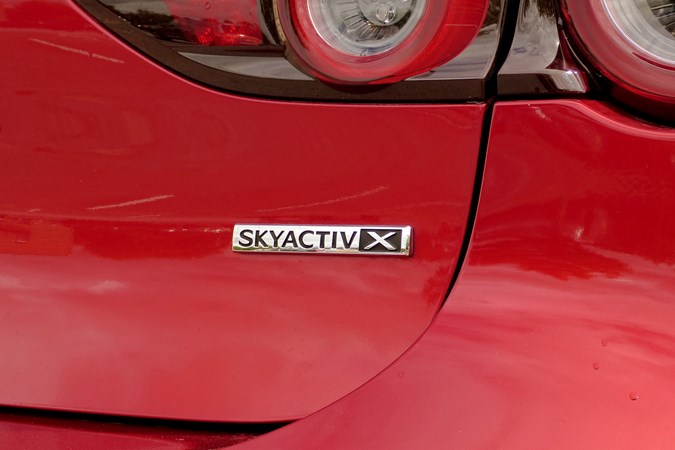
The engine character is rather soulless, feeling a little lumpy as it reluctantly revs through the range – even if it has loosened up a little as the miles have gone by – plus, the laughably long gearing means the engine can get bogged down if you reduce your speed and try to regain momentum, as you get caught out by being in one too high a gear at times.
This setup might be great for keeping your average mpg figure, but you also risk ruining all that by having to work the engine hard just to get any discernible pace – which is why I suspect the average figure dropped as time went by and other members of the team borrowed the 3.
The mild-hybrid technology works seamlessly, however. I love how unobtrusive it is when it wakes up the engine again when you want to set off. There’s no starter motor coughing the engine back into life in stop-start traffic, and even the new SEAT Leon’s system wasn’t quite as smooth as our long termer.
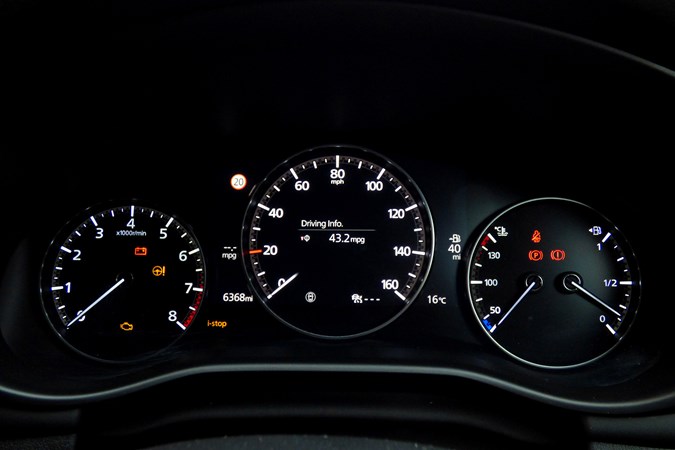
Speaking of which, the 1.5-litre engine I tested in the Leon may be down on power by 30hp, but the muscular, turbocharged nature meant it felt no slower than our more powerful Mazda. It also managed to better our mpg figures with ease, helped by its cylinder-deactivation, so it’s actually closer as a rival than expected – even if those numbers did tumble under spirited driving.
Should you get one?
Yes. If you forget any notion of performance from the SkyActiv-X engine and focus on the fuel economy and comfort on offer, you’ll have a hatchback that’s relaxing to drive, easy to live with and handles quite sweetly. The CX-30 offers better rear passenger space and a brighter cabin if you seek something similar – incidentally, this is what I’ll be moving onto next!
| Long-term test: Mazda 3 | |
| Mileage | 6,369 |
| Real-world economy | 41.1mpg, 84% of official |
| Official economy / MPP | 48.7mpg / 7.1 |
| Joined Parkers | November 2019 |



